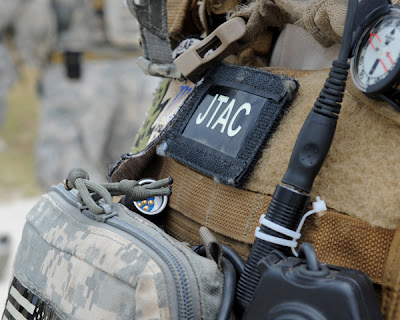 | |||
| Senior Airman Caleb Pierce / Air Force The Air Force has more than doubled the number of joint terminal attack controllers in Afghanistan. |
Posted : Monday Jan 3, 2011
The Air Force has more than doubled the number of airmen in Afghanistan who call in air strikes, as the use of bombs, missiles and strafing runs has spiked to its highest level since the war began.
The Air Force has increased the number of joint terminal attack controllers — the airmen who work with soldiers to coordinate air strikes — to 134 last year in Afghanistan, up from 53 in 2009, said Maj. Ike Williams, an operations officer at Air Combat Command in Langley, Va.
The increasing reliance on air strikes and the troops who direct them comes as the U.S. military has raised its troop level in Afghanistan to 100,000, including 30,000 deployed last year.
Those troops often rely on bombs to repel attacks and help them destroy Taliban strongholds.
"What you're seeing is a reaction to the enemy on the ground," said Air Force Col. Richard Gannon, an air operations commander in an interview Sunday from Kabul. "It's a resilient enemy and an enemy that's persistent."
The more aggressive approach, military analysts say, may provide better protection for U.S. and NATO troops and help kill insurgents, but it also can infuriate Afghan officials and civilians.
"This is a main irritant between the Afghan population and NATO," said Arturo Munoz, a political scientist at the RAND Corp. and a former top counter-terrorism official at the CIA.
"If you had to single out one main complaint, without a doubt air strikes and civilian casualties caused by air strikes would be it," Munoz said.
There are signs, however, that the coalition's emphasis on reducing civilian casualties is working. The number of civilian casualties — including death and injuries — caused by coalition and Afghan forces in the first 10 months of last year was 742, a 18 percent decrease over the same period in 2009, according to a United Nations report.
On Jan. 1, a Taliban insurgent responsible for makeshift bomb attacks was killed in a "precision air strike," according to NATO. Air crews waited until he had moved into an open field, away from civilians, before killing him.
The troops who control air strikes are in high demand in Afghanistan and in many cases spend as much time in combat as they do at home, Williams said. They spend six months or a year embedded with Army units and some have deployed five or more times.
They serve as a go-between with Army commanders and pilots, coordinating bomb drops or aerial surveillance of insurgents.
In October, they helped coordinate 1,000 missions in which warplanes dropped bombs or fired missiles or guns, the most ever, topping the previous peak of 984 in June 2008.
To keep pace with demand in Afghanistan and to embed them with units throughout the Army, the Air Force has increased the number of airmen trained for the job. There are 630 of them now, and the Air Force plans to have 1,038 by 2014, Williams said.
Training can take four years, he said, and about a third who enter will fail.
They carry what a normal soldier would carry plus a radio and other equipment to call in air strikes. It can sometimes exceed 100 pounds of gear.
"You've got to be physically tough, and you have to be savvy," Williams said.
Barry Watts, of the Center for Strategic and Budgetary Assessments, said the Air Force has needed more controllers for years. The more aggressive use of air power, he said, reflects an effort by the coalition to hammer insurgents before troop withdrawals begin this year.